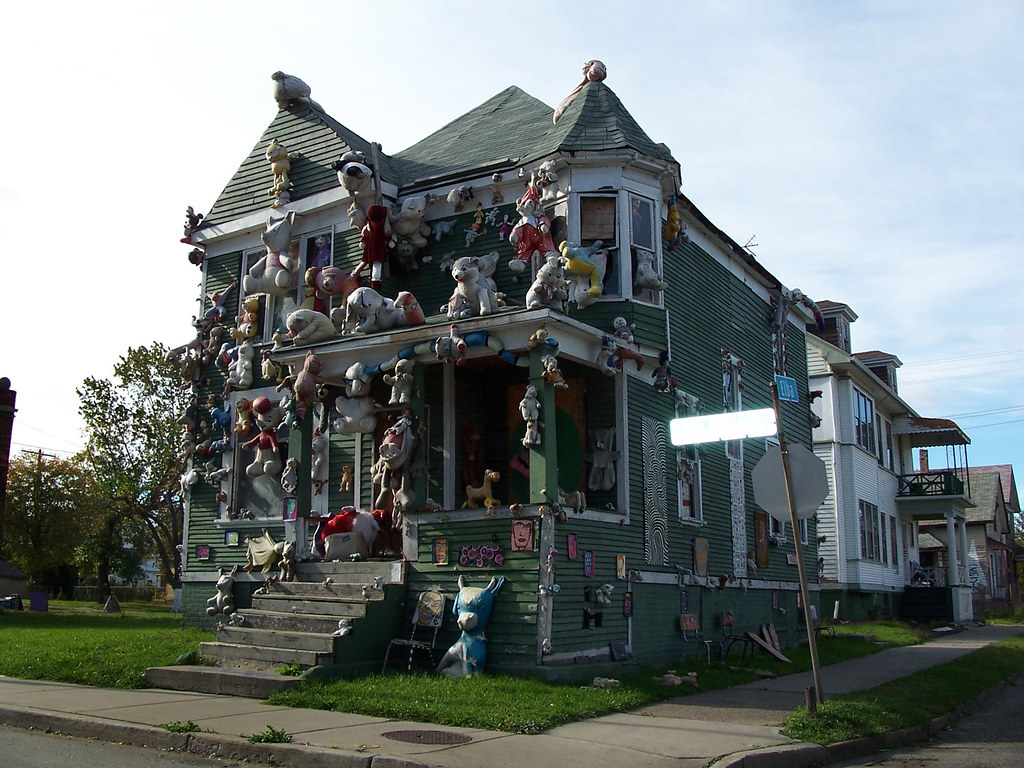The Heidelberg Project

Click on the photo to view large.
I found this house while exploring Detroit with a friend, taking pictures. It was something that I had never seen before. I was later informed that it is part of the Heidelberg Project. I had heard of it as something negative in the past, an embarrasment and thought the city had destroyed it. I didn't realize that the project had been resurrected and is the biggest tourist attraction in the city of Detroit.
From the Heidelberg website:
The Heidelberg Project has transformed a hard-core inner city neighborhood where people were afraid to walk, even in daytime, into one in which neighbors take pride and where visitors are many and welcome. The success of the Project continues to provide hope and inspiration.
"See that house over there? That was a crack house...After the first three police raids, it opened right up again. After the fourth raid we couldn't stand it anymore. So we went over and painted the place. Pink, blue, yellow, white and purple dots and squared all over it. Up there on the roof we stuck a baby doll and that bright blue inner tube, and on the porch we put a doghouse with a watchdog inside...Now all day long people drive by and stop to stare at the place...Believe me, in front of an audience like that, nobody's going to sell crack out of that house anymore."
Tyree Guyton (from People Magazine, August 15, 1988)
I believe that art can change the world and Tyree Guyton has proved it. If you go to the web site you can take a tour of the homes that have been transformed into art. It hasn't been an easy journey. Mayor Coleman Young ordered the demolition of 4 of the houses in 1991. This happened during a time when abandoned houses became a risk to children walking to school and it seemed illogical to destroy the homes that were decorated so colorfully. Dennis Archer was elected Mayor in 1993.
In 1997, The Heidelberg Project receives a $47,500 grant from the City of Detroit for the development of a Cafe and Welcoming Center. In October council members Kay Everett and Sheila Cockerel declare war against the Heidelberg Project.
February 4th - 5th, 1999
Police cars block off Heidelberg Street. Within 90 minutes, an army of city workers and heavy equipment descends on the Project. Police helicopters hover over the scene. Many Detroiters are startled that the city was able to mobilize such a large force of workers and equipment in mere hours.
This action is not rational, this decision is political...and this attack is personal. The City Government is flexing its muscles like a schoolyard bully and using Detroit's limited financial resources to do it.
Local media quoted the city as saying the estimated cost to destroy the project would be approximately $18,000. If the city had given that money to the Heidelberg Project, we could have purchased and renovated one of the homes the city chose to bulldoze and set up a center for art and educational programs for local children - as we planned to do last Fall before the city declared war on the Project and made obtaining funding all but impossible. Instead the city has created another vacant lot...
The "Happy Feet" house is demolished as supporters rush to gather artwork from city lots for storage on private property. One of the vacant houses demolished was owned by a local senior citizen. City bulldozers also destroyed a house blocks away on Canfield Street. The Canfield House was owned by Tyree Guyton and used as a storage facility for artwork saved from the 1991 demolition of the original Heidelberg Project.
The Heidelberg Project began as an outdoor art environment in the heart of Detroit, but it has grown into much more. Today the project is recognized around the world as a demonstration of the power of creativity to transform all those whose lives it touches. The Heidelberg Project offers a forum for ideas, a seed of hope, and a bright vision for the future.


0 Comments:
Post a Comment
Subscribe to Post Comments [Atom]
<< Home